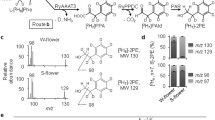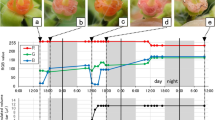Abstract
Previous studies have shown diurnal oscillation of scent emission in rose flowers with a peak during the day (Helsper in Planta 207:88–95, 1998; Picone in Planta 219:468–478, 2004). Here, we studied the regulation of scent production and emission in Rosa hybrida cv. Fragrant Cloud during the daily cycle and focused on two terpenoid compounds, germacrene D and geranyl acetate, whose biosynthetic genes have been characterized by us previously. The emission of geranyl acetate oscillated during the daily light/dark cycle with a peak early in the light period. A similar daily fluctuation was found in the endogenous level of this compound and in the expression of its biosynthetic gene, alcohol acetyl transferase (RhAAT). The rhythmic expression of RhAAT continued under conditions of constant light or darkness, indicating regulation by the endogenous circadian clock. However, the accumulation and emission of geranyl acetate ceased under continuous light. Our results suggest that geranyl acetate production is limited by the level of its substrate geraniol, which is suppressed under constant light conditions. The emission of germacrene D also oscillated during the daily cycle with a peak early in the light period. However, the endogenous level of this compound and the expression of its biosynthetic gene germacrene D synthase (RhGDS) were constant throughout the day. The diurnal oscillation of germacrene D emission ceased under continuous light, suggesting direct regulation by light. Our results demonstrate the complexity of the diurnal regulation of scent emission: although the daily emission of most scent compounds is synchronized, various independently evolved mechanisms control the production, accumulation and release of different volatiles.








Similar content being viewed by others
Abbreviations
- 2-PE:
-
2-Phenylethanol
- 2-PEG:
-
Glycosylated 2-PE;
- BAMT:
-
Benzoic acid carboxyl methyltransferase
- RhAAT:
-
Rosa hybrida alcohol acetyl transferase
- RhGDS:
-
Rosa hybrida germacrene D synthase
- SAMT:
-
S-Adenosyl-l-Met:salicylic acid carboxyl methyltransferase
References
Croteau R, Karp F (1991) Origin of natural odorants. In: Muller P, Lamparsky D (eds) Perfume: art, science and technology. Elsevier Applied Sciences, New York, pp 101–126
Croteau R, Kutchan TM, Lewis NG (2000) Natural products (secondary metabolites). In: Buchanan B, Gruissem W, Jones R (eds) Biochemistry and molecular biology of plants. American Society of Plant Physiologists, Rockville, pp 1250–1318
Dobson HEM, Bergstrom G, Groth I (1990) Differences in fragrance chemistry between flower parts of Rosa rugosa Thunb. (Rosaceae). Isr J Bot 39:143–156
Dudareva N, Pichersky E (2000) Biochemical and molecular genetic aspects of floral scents. Plant Physiol 122:627–633
Dudareva N, Negre F (2005) Practical applications of research into the regulation of plant volatile emission. Curr Opin Plant Biol 8:113–118
Dudareva N, Murfitt LM, Mann CJ, Gorenstein N, Kolosova N, Kish CM, Bonham C, Wood K (2000) Developmental regulation of methyl benzoate biosynthesis and emission in snapdragon flowers. Plant Cell 12:949–961
Dudareva N, Martin D, Kish CM, Kolosova N, Gorenstein N, Faldt J, Miller B, Bohlmann J (2003) (E)-{β}-ocimene and myrcene synthase genes of floral scent biosynthesis in snapdragon: function and expression of three terpene synthase genes of a new terpene synthase subfamily. Plant Cell 15:1227–1241
Dudareva N, Pichersky E, Gershenzon J (2004) Biochemistry of plant volatiles. Plant Physiol 135:1893–1902
Guterman I, Shalit M, Menda N, Piestun D, Dafny-Yelin M, Shalev G, Davydov O, Ovadis M, Emanuel M, Wang J, Adam Z, Pichersky E, Lewinsohn E, Zamir D, Vainstein A, Weiss D (2002) Rose scent: genomic approach to discover novel floral fragrance-related genes. Plant Cell 14:2325–2338
Helsper JPFG, Davies JA, Bouwmeester HJ, Krol AF, van Kampen MH (1998) Circadian rhythmicity in emission of volatile compounds by flowers of Rosa hybrida L. cv. Honesty. Planta 207:88–95
Hoballah ME, Stuurman J, Turlings TCJ, Guerin PM, Connetable S, Kuhlemeier C (2005) The composition and timing of flower odour emission by wild Petunia axillaris coincide with the antennal perception and nocturnal activity of the pollinator Manduca sexta. Planta 222:141–150
Jakobsen HB, Olsen CE (1994) Influence of climactic factors on emission of flower volatiles in situ. Planta 192:365–371
Jetter R (2006) Examination of processes involved in the emission of scent volatioles. In: Dudareva N, Pichersky ER (eds) Biology of floral scent. CRC, Boca Raton, pp 125–144
Jones MB, Mansfield TA (1975) Circadian rhythms in plants. Sci Prog Oxford 62:103–125
Knudsen JT, Tollesten L, Bergstrom GL (1993) Floral scent—a checklist of volatile compounds isolated by head-space techniques. Phytochemistry 33:252–280
Knudsen JT, Eriksson R, Gershenzon J, Stahl B (2006) Diversity and distribution of floral scent. Bot Rev 72:1–120
Kolosova N, Gorenstein N, Kish CM, Dudareva N (2001) Regulation of circadian methyl benzoate emission in diurnally and nocturnally emitting plants. Plant Cell 13:2333–2347
Lavid N, Wang J, Shalit M, Gutterman I, Bar E, Beuerle T, Menda N, Shafir S, Zamir D, Adam Z, Vainstein A, Weiss D, Pichersky E, Lewinsohn E (2002) O-methyltransferases involved in the biosynthesis of volatile phenolic derivatives in rose petals. Plant Physiol 129:1899–1907
Loughrin JH, Hamilton-Kemp TR, Andersen RA, Hildebrand DF (1991) Circadian rhythm of volatile emission from flower of Nicotiana sylvestris and N. suaveolens. Physiol Plant 83:492–496
Pham-Delegue MH, Etievant P, Guichard E, Marilleau R, Douault P, Chauffaille J, Masson C (1990) Chemicals involved in honeybee-sunflower relationship. J Chem Ecol 16:3053–3065
Picone MJ, Clery RA, Watanabe N, MacTavish HS, Turnbull CGN (2004) Rhythmic emission of floral volatiles from Rosa damascena semperflorens cv. ‘Quatre Saisons’. Planta 219:468–478
Pittendrigh CS (1960) Circadian rhythms and the circadian organization of living systems. Cold Spring Harb Symp Quant Biol 25:159–184
Pott MB, Effmert U, Piechulla B (2003) Transcriptional and post-translational regulation of S-adenosyl-l-methionine: salicylic acid carboxyl methyltransferase (SAMT) during Stephanotis floribunda flower development. J Plant Physiol 160:635–643
Raguso RA, Pichersky E (1995) Floral volatiles from Clarkia breweri and Clarkia concinna (Onagraceae): recent evolution of floral scent and moth pollination. Plant Syst Evol 194:55–67
Raguso RA, Light DM, Pichersky E (1996) Electroantennogram responses of Hyles lineata (Sphingidae: Lepidoptera) to volatile compounds from Clarkia breweri (Onagraceae) and other moth-pollinated flowers. J Chem Ecol 22:1735–1766
Schuurink RC, Haring MA, Clark DG (2006) Regulation of volatile benzenoid biosynthesis in petunia flowers. Trends Plant Sci 11:20–25
Shalit M, Guterman I, Volpin H, Bar E, Tamari T, Menda N, Adam Z, Zamir D, Vainstein A, Weiss D, Pichersky E, Lewinsohn E (2003) Volatile ester formation in roses: identification of an acetyl-CoA:geraniol acetyltransferase in developing rose petals. Plant Physiol 131:1868–1876
Shalit M, Shafir S, Larkov O, Bar E, Kaslassi D, Adam Z, Zamir D, Vainstein A, Weiss D, Ravid U, Lewinsohn E (2004) Volatile compounds emitted by rose cultivars: fragrance perception by man and honey bees. Isr J Plant Sci 52:245–255
Simkin AJ, Underwood BA, Auldridge M, Loucas HM, Shibuya K, Schmelz E, Clark DG, Klee HJ (2004) Circadian regulation of the PhCCD1 carotenoid cleavage dioxygenase controls emission of beta-ionone, a fragrance volatile of petunia. Plant Physiol 136:3504–3514
Underwood BA, Tieman DM, Shibuya K, Dexter RJ, Loucas HM, Simkin AJ, Sims CA, Schmelz EA, Klee HJ, Clark DG (2005) Ethylene-regulated floral volatile synthesis in petunia corollas. Plant Physiol 138:255–266
Vainstein A, Lewinsohn E, Pichersky E, Weiss D (2001) Floral fragrance. New inroads into an old commodity. Plant Physiol 127:1383–1389
Weiss EA (1997) Essential oil crops. CAB International, Wallingford Oxon, p 411
Acknowledgments
This work was supported by the US Israel Binational Agriculture Research and Development fund (grant no. US-3437) and by the Pearlstein Fund for research in floriculture at the Hebrew University. We thank the donors for their help.
Author information
Authors and Affiliations
Corresponding author
Electronic supplementary material
Rights and permissions
About this article
Cite this article
Hendel-Rahmanim, K., Masci, T., Vainstein, A. et al. Diurnal regulation of scent emission in rose flowers. Planta 226, 1491–1499 (2007). https://doi.org/10.1007/s00425-007-0582-3
Received:
Revised:
Accepted:
Published:
Issue Date:
DOI: https://doi.org/10.1007/s00425-007-0582-3




